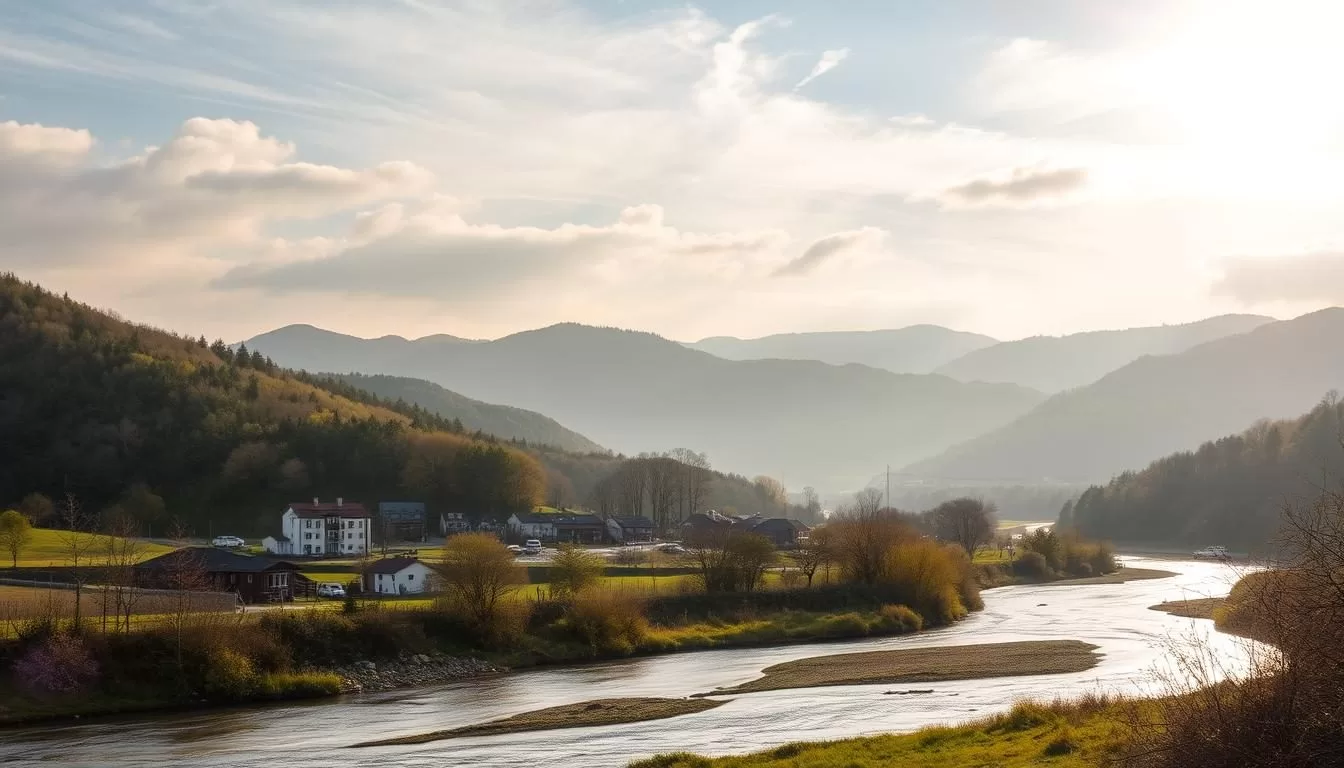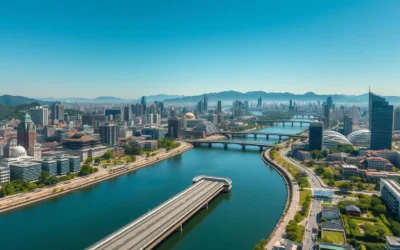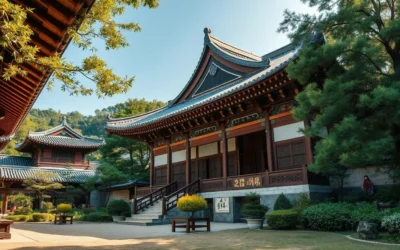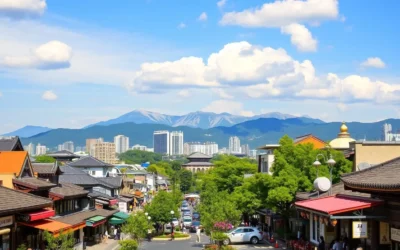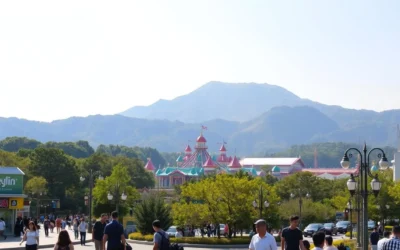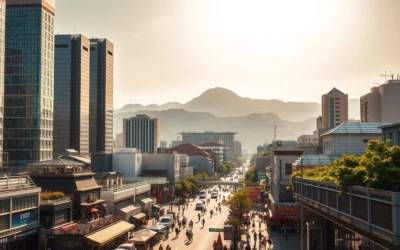✓ Accommodations✓ Flights✓ Rental Cars
Planning a trip to Gangwon Province in South Korea requires understanding its unique weather patterns to make the most of your visit. Unlike many other destinations in Asia, South Korea’s weather is relatively straightforward, with four distinct seasons.
The timing of your trip is crucial as Gangwon Province offers diverse landscapes and outdoor activities that are heavily influenced by its weather. From snow sports to cherry blossoms, and from beach activities to fall foliage, each season provides a unique experience.
Understanding the factors that influence South Korea’s weather, such as its mountainous terrain and location on the Korean peninsula, will help you determine the best time to visit. This guide will walk you through the province’s climate to plan a weather-savvy trip.
Understanding Gangwon Province’s Unique Climate
Understanding Gangwon Province’s climate requires a look at its geographical features. Located in the northeastern part of South Korea, Gangwon Province’s diverse geography plays a significant role in shaping its weather patterns.
Geographical Features That Influence Weather
Gangwon Province’s geography is characterized by its mountainous interior and eastern coastal areas. The province’s varied topography leads to diverse climate zones within Gangwon itself. For instance, Pyeongchang, known for its ski resorts, is one of the snowiest areas in South Korea, with an average of 12 snowy days a month from December to March.
- The mountainous regions experience colder temperatures and longer winters.
- The eastern coastal areas have milder temperatures compared to the interior.
How Gangwon’s Climate Differs From the Rest of South Korea
Gangwon Province’s climate differs significantly from other parts of South Korea. The province experiences longer, colder winters than Seoul or Busan, with snow lasting from late November through March. Additionally, Gangwon’s seasons transition, particularly from winter to spring, often lag behind the rest of South Korea, affecting the optimal time for activities like cherry blossom viewing. The summer monsoon season in Gangwon may be less intense than in other parts of the country, but its mountain valleys can experience sudden weather changes.
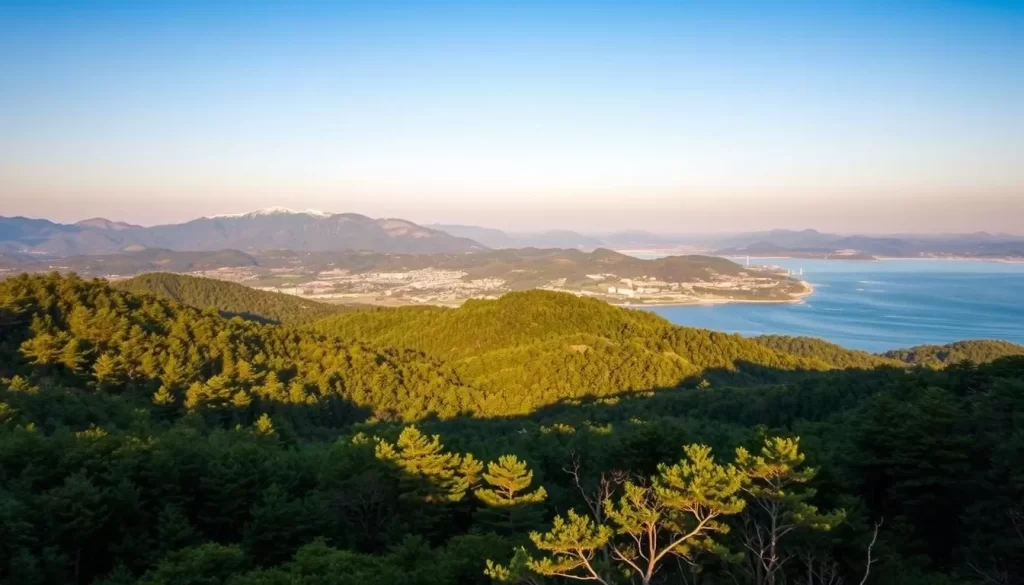
Winter in Gangwon Province (December to March)
Winter in Gangwon Province, South Korea, is a season of enchantment, with snow-covered mountains, frozen lakes, and a plethora of winter activities to enjoy. As you plan your trip, understanding the climate and events during this period can enhance your experience.
Temperature and Snowfall Patterns
Gangwon Province experiences cold temperatures during winter, with significant snowfall, especially in the mountainous regions. The average temperature ranges from -2°C to -10°C (28°F to 14°F), making it ideal for winter sports. Snowfall is abundant, with some areas receiving over 100 cm of snow, perfect for skiing and snowboarding.
Winter Sports and Activities in Pyeongchang
Pyeongchang, known for hosting the Winter Olympics, offers a variety of winter sports and activities. You can enjoy skiing, snowboarding, and ice skating at world-class facilities. The region also hosts several winter festivals that add to the excitement, making Pyeongchang a must-visit destination in South Korea during winter.
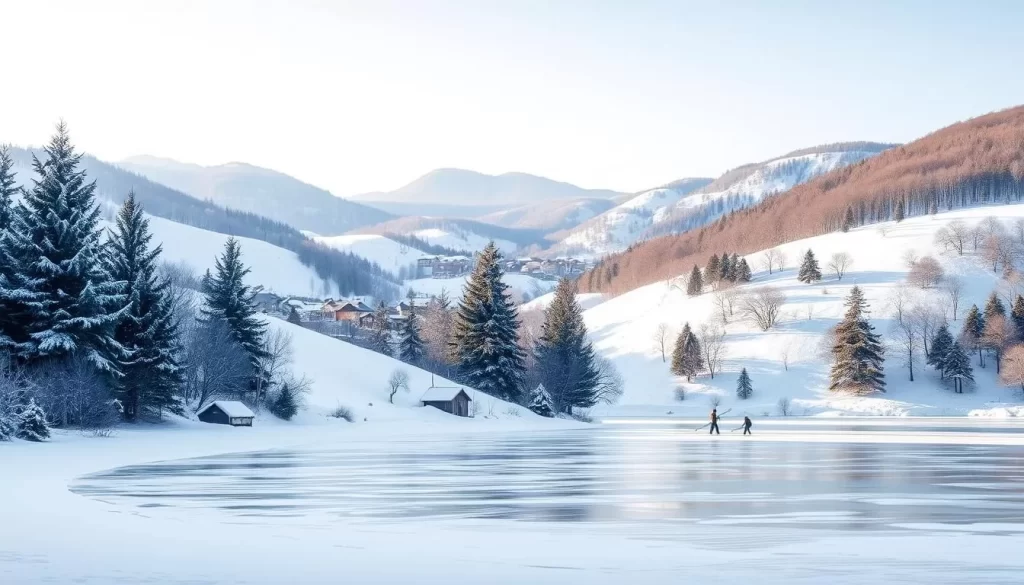
Winter Festivals Worth Experiencing
Gangwon Province is renowned for its vibrant winter festivals. You can experience the Pyeongchang Trout Festival, where you can try ice fishing, or the Taebaeksan Mountain Snow Festival, featuring massive snow sculptures. The Hwacheon Sancheoneo Ice Festival is another highlight, where you can catch trout with your bare hands through holes in the frozen river. These festivals showcase the region’s winter beauty and cultural heritage.
Spring Awakening (April to June)
As the last wisps of winter dissipate, Gangwon Province transforms into a vibrant landscape, inviting travelers to experience its spring splendor. The season brings a renewed sense of life to the region, making it a perfect time to explore the great outdoors.
Temperature Ranges and Weather Conditions
During the spring months, Gangwon Province enjoys mild temperatures, ranging from 10°C to 25°C (50°F to 77°F), making it ideal for outdoor activities. You can expect sunny days with gentle breezes, although occasional rain showers are not uncommon.
Cherry Blossom Viewing Opportunities
Spring in Gangwon Province is synonymous with cherry blossoms, which typically bloom in late March to early April. Popular spots like Jeongdongjin and Gangneung offer picturesque views of these beautiful flowers, attracting visitors from all over South Korea.
Hiking and Outdoor Activities
With the snow melted and summer crowds yet to arrive, spring is considered the best time for hiking in Gangwon Province, particularly in Seoraksan National Park. You can explore premier hiking trails such as Odaesan National Park’s Birobong Peak trail or the coastal path from Jeongdongjin to Chuam Beach. Additionally, spring-specific activities like wild vegetable foraging (known as “sanchae” gathering) are a popular tradition in Gangwon’s mountain villages.
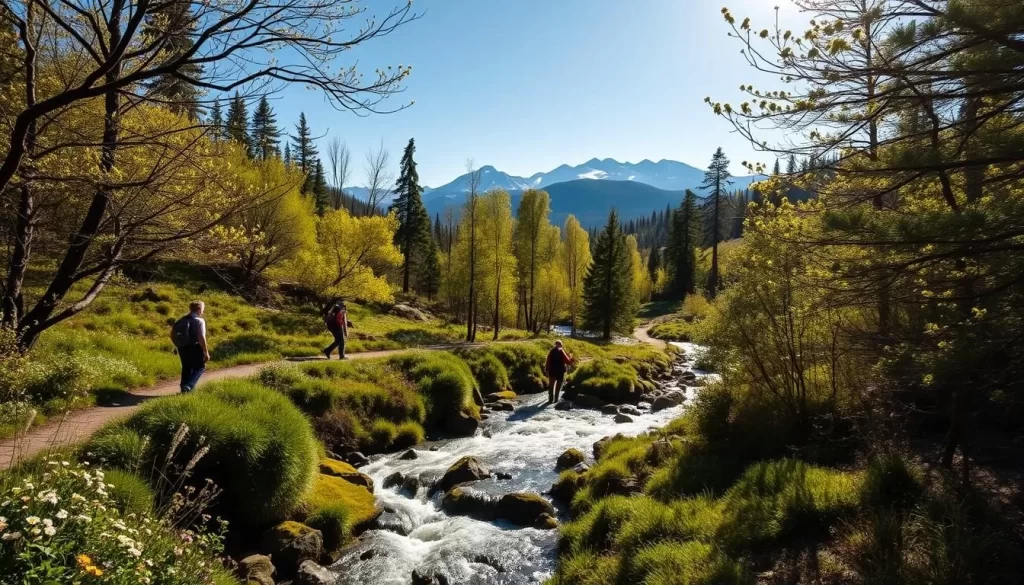
May is generally considered the optimal time for spring activities, offering a perfect balance of comfortable temperatures, blooming wildflowers, and minimal rainfall. However, it’s worth noting that during South Korean holidays like Buddha’s Birthday (usually in May), domestic tourism peaks, and accommodations in natural areas can become scarce.
Summer Heat and Monsoon Season (July to August)
When summer arrives in South Korea, Gangwon Province becomes a sought-after destination for those seeking relief from the heat. The region’s unique blend of coastal and mountainous landscapes offers a refreshing escape from the sweltering temperatures and humidity found in cities like Busan.
Humidity, Rainfall, and Temperature Expectations
Summer in Gangwon Province is characterized by high temperatures and humidity, followed by the monsoon season. You can expect significant rainfall during this period, with temperatures often soaring during the dry spells. The region’s climate is generally more temperate than inland areas of South Korea, making it an attractive summer getaway.
Beach Escapes and Water Activities
Gangwon Province’s east coast beaches, such as Gyeongpo Beach in Gangneung and Sokcho Beach, become popular summer destinations. You can enjoy various water activities, including surfing at Yangyang, paddleboarding on Gyeongpo Lake, and fishing excursions from coastal towns. The unique beach culture, complete with seafood tents (pojangmacha) offering fresh catches, adds to the region’s appeal. 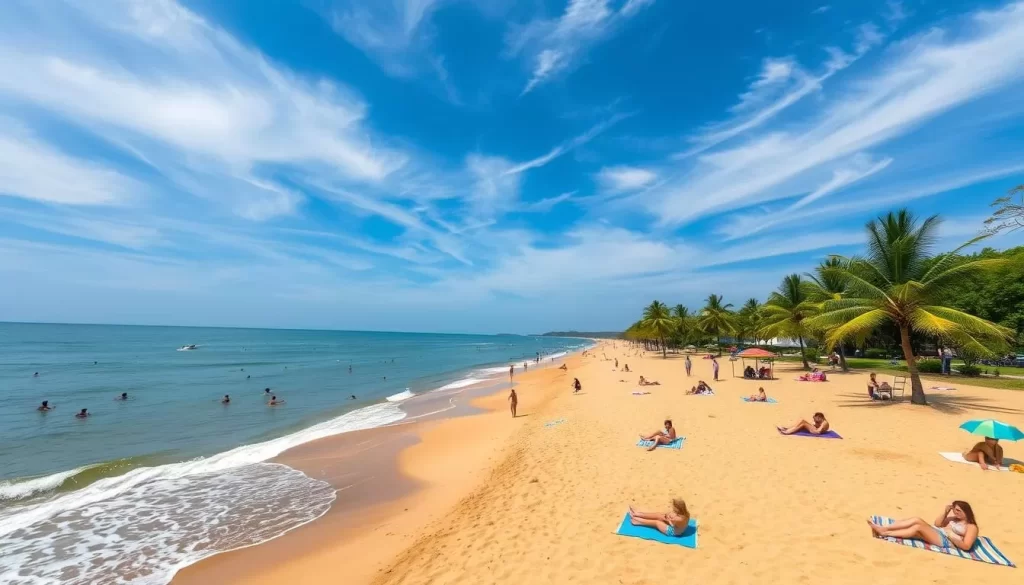
The coastal festivals, including the Gangneung Danoje Festival, a UNESCO Intangible Cultural Heritage event, and various seafood festivals, make summer a vibrant time to visit Gangwon Province.
Autumn Colors in Gangwon Province (September to November)
Autumn in Gangwon Province is a spectacle of vibrant colors and cultural festivities that you won’t want to miss. As the summer heat dissipates, the region transforms into a haven of natural beauty, attracting visitors from all over.
Temperature Trends and Foliage Timeline
During autumn, Gangwon Province experiences a gradual cooling of temperatures, making it an ideal time for outdoor activities. The foliage timeline typically peaks in mid-to-late October, with the exact timing varying depending on weather conditions. You can expect comfortable temperatures ranging from 10°C to 20°C (50°F to 68°F), perfect for hiking and exploring the region’s natural beauty.
Best National Parks for Fall Foliage
Gangwon Province is home to several national parks that are renowned for their stunning autumn foliage. Some of the best parks to visit include:
- Seoraksan National Park, known for its vibrant maple trees and scenic hiking trails.
- Chiaksan National Park, offering breathtaking views of the autumn landscape.
- Odaesan National Park, a haven for nature lovers with its diverse flora and fauna.
The parks are not only visually stunning but also provide a range of outdoor activities for visitors to enjoy.
Harvest Festivals and Cultural Events
Autumn in Gangwon Province is also a time for harvest festivals and cultural events. You can experience the region’s rich cultural heritage by attending festivals such as the Yangyang Songi Mushroom Festival, Chuseok (Korean Thanksgiving), and the Gangneung Coffee Festival. These events offer a glimpse into the local culture, with traditional food, music, and agricultural demonstrations.
| Festival/Event | Date | Description |
|---|---|---|
| Yangyang Songi Mushroom Festival | Late September | Celebrates the prized pine mushrooms of the region. |
| Chuseok (Korean Thanksgiving) | 15th day of the 8th lunar month | A time for family reunions and traditional foods. |
| Gangneung Coffee Festival | October | A celebration of coffee culture with various events. |
Gangwon Province, South Korea: Best Months for a Weather-Savvy Trip
The key to a memorable trip to Gangwon Province lies in choosing the right time to visit, balancing weather and crowd considerations. Understanding the optimal periods for your preferred activities can significantly enhance your travel experience.
Optimal Months for Different Travel Experiences
For a best time visit, consider the shoulder seasons. Late April and early June offer pleasant weather with fewer crowds, making them ideal for outdoor activities like hiking. Late September is another excellent period, with comfortable temperatures and stunning autumn foliage.
Avoiding Peak Tourist Seasons
To avoid the peak tourist season, steer clear of major festivals like Chuseok and Seollal, when many locals travel, and establishments may close. Visiting during weekdays instead of weekends can also make a significant difference, especially at popular destinations like Seoraksan National Park.
By choosing your time visit wisely, you can enjoy Gangwon Province’s attractions without the hustle and bustle of crowds, making for a more relaxed and enjoyable trip.
Practical Travel Tips for Each Season
When planning your trip to Gangwon Province, South Korea, it’s essential to consider the practical aspects of traveling during different seasons. Being prepared for the seasonal variations can significantly enhance your travel experience.
What to Pack Based on Weather Conditions
Packing appropriately is crucial for a comfortable trip. For winter (December to March), bring warm clothing, including thermal layers and waterproof gear, as temperatures can drop below freezing. In spring (April to June) and autumn (September to November), layers are still advisable due to fluctuating temperatures, along with comfortable walking shoes for outdoor activities. Summer (July to August) calls for light, breathable clothing and rain gear due to the monsoon season.
Transportation Considerations During Different Seasons
Transportation in Gangwon Province varies by season. In winter, be prepared for occasional mountain road closures and consider winter tires or chains when traveling to ski resorts. During spring and autumn, excellent public transportation options are available, including seasonal buses to popular hiking spots and viewing areas. In summer, be aware of potential transportation challenges due to heavy rains, which can cause delays on mountain roads.
Conclusion
Gangwon Province’s unique climate offers something for everyone. You’ve gained a comprehensive understanding of how the province’s weather patterns impact travel experiences throughout the year.
From winter’s snow sports to spring’s cherry blossoms, each season has its charm. The best time to visit depends on your preferences: winter for snow sports, mid-April for cherry blossoms, or October for fall colors.
Now, you’re equipped to plan a weather-savvy trip that aligns with your interests, whether visiting in March or April or at any other time.
The above is subject to change.
Check back often to TRAVEL.COM for the latest travel tips and deals.
